Jukka Talvitie
Target Handover in Distributed Integrated Sensing and Communication
Nov 04, 2024Abstract:The concept of 6G distributed integrated sensing and communications (DISAC) builds upon the functionality of integrated sensing and communications (ISAC) by integrating distributed architectures, significantly enhancing both sensing and communication coverage and performance. In 6G DISAC systems, tracking target trajectories requires base stations (BSs) to hand over their tracked targets to neighboring BSs. Determining what information to share, where, how, and when is critical to effective handover. This paper addresses the target handover challenge in DISAC systems and introduces a method enabling BSs to share essential target trajectory information at appropriate time steps, facilitating seamless handovers to other BSs. The target tracking problem is tackled using the standard trajectory Poisson multi-Bernoulli mixture (TPMBM) filter, enhanced with the proposed handover algorithm. Simulation results confirm the effectiveness of the implemented tracking solution.
Batch SLAM with PMBM Data Association Sampling and Graph-Based Optimization
Jul 16, 2024



Abstract:Simultaneous localization and mapping (SLAM) methods need to both solve the data association (DA) problem and the joint estimation of the sensor trajectory and the map, conditioned on a DA. In this paper, we propose a novel integrated approach to solve both the DA problem and the batch SLAM problem simultaneously, combining random finite set (RFS) theory and the graph-based SLAM approach. A sampling method based on the Poisson multi-Bernoulli mixture (PMBM) density is designed for dealing with the DA uncertainty, and a graph-based SLAM solver is applied for the conditional SLAM problem. In the end, a post-processing approach is applied to merge SLAM results from different iterations. Using synthetic data, it is demonstrated that the proposed SLAM approach achieves performance close to the posterior Cram\'er-Rao bound, and outperforms state-of-the-art RFS-based SLAM filters in high clutter and high process noise scenarios.
Robust NLoS Localization in 5G mmWave Networks: Data-based Methods and Performance
Jun 24, 2024



Abstract:Ensuring smooth mobility management while employing directional beamformed transmissions in 5G millimeter-wave networks calls for robust and accurate user equipment (UE) localization and tracking. In this article, we develop neural network-based positioning models with time- and frequency-domain channel state information (CSI) data in harsh non-line-of-sight (NLoS) conditions. We propose a novel frequency-domain feature extraction, which combines relative phase differences and received powers across resource blocks, and offers robust performance and reliability. Additionally, we exploit the multipath components and propose an aggregate time-domain feature combining time-of-flight, angle-of-arrival and received path-wise powers. Importantly, the temporal correlations are also harnessed in the form of sequence processing neural networks, which prove to be of particular benefit for vehicular UEs. Realistic numerical evaluations in large-scale line-of-sight (LoS)-obstructed urban environment with moving vehicles are provided, building on full ray-tracing based propagation modeling. The results show the robustness of the proposed CSI features in terms of positioning accuracy, and that the proposed models reliably localize UEs even in the absence of a LoS path, clearly outperforming the state-of-the-art with similar or even reduced processing complexity. The proposed sequence-based neural network model is capable of tracking the UE position, speed and heading simultaneously despite the strong uncertainties in the CSI measurements. Finally, it is shown that differences between the training and online inference environments can be efficiently addressed and alleviated through transfer learning.
Robust Snapshot Radio SLAM
Apr 16, 2024



Abstract:The intrinsic geometric connections between millimeter-wave (mmWave) signals and the propagation environment can be leveraged for simultaneous localization and mapping (SLAM) in 5G and beyond networks. However, estimated channel parameters that are mismatched to the utilized geometric model can cause the SLAM solution to degrade. In this paper, we propose a robust snapshot radio SLAM algorithm for mixed line-of-sight (LoS) and non-line-of-sight (NLoS) environments that can estimate the unknown user equipment (UE) state, map of the environment as well as the presence of the LoS path. The proposed method can accurately detect outliers and the LoS path, enabling robust estimation in both LoS and NLoS conditions. The proposed method is validated using 60 GHz experimental data, indicating superior performance compared to the state-of-the-art.
Millimeter-wave Radio SLAM: End-to-End Processing Methods and Experimental Validation
Dec 21, 2023Abstract:In this article, we address the timely topic of cellular bistatic simultaneous localization and mapping (SLAM) with specific focus on complete processing solutions from raw I/Q samples to user equipment (UE) and landmark location information in millimeter-wave (mmWave) networks. Firstly, we propose a new multipath channel parameter estimation solution which operates directly with beam reference signal received power (BRSRP) measurements, alleviating the need to know the true antenna beampatterns or the underlying beamforming weights. Additionally, the method has built-in robustness against unavoidable antenna sidelobes. Secondly, we propose new snapshot SLAM algorithms that have increased robustness and identifiability compared to prior-art, in practical built environments with complex clutter and multi-bounce propagation scenarios. The performance of the proposed methods is assessed at the 60 GHz mmWave band, via both realistic ray-tracing evaluations as well as true experimental measurements, in an indoor environment. Wide set of offered results clearly demonstrate the improved performance, compared to the relevant prior-art, in terms of the channel parameter estimation as well as the end-to-end SLAM performance. Finally, the article provides the measured 60 GHz data openly available for the research community, facilitating results reproducibility as well as further algorithm development.
Joint RIS Calibration and Multi-User Positioning
Dec 08, 2022Abstract:Reconfigurable intelligent surfaces (RISs) are expected to be a key component enabling the mobile network evolution towards a flexible and intelligent 6G wireless platform. In most of the research works so far, RIS has been treated as a passive base station (BS) with a known state, in terms of its location and orientation, to boost the communication and/or terminal positioning performance. However, such performance gains cannot be guaranteed anymore when the RIS state is not perfectly known. In this paper, by taking the RIS state uncertainty into account, we formulate and study the performance of a joint RIS calibration and user positioning (JrCUP) scheme. From the Fisher information perspective, we formulate the JrCUP problem in a network-centric single-input multiple-output (SIMO) scenario with a single BS, and derive the analytical lower bound for the states of both user and RIS. We also demonstrate the geometric impact of different user locations on the JrCUP performance while also characterizing the performance under different RIS sizes. Finally, the study is extended to a multi-user scenario, shown to further improve the state estimation performance.
MmWave Mapping and SLAM for 5G and Beyond
Nov 29, 2022



Abstract:Device localization and radar-like mapping are at the heart of integrated sensing and communication, enabling not only new services and applications, but can also improve communication quality with reduced overheads. These forms of sensing are however susceptible to data association problems, due to the unknown relation between measurements and detected objects or targets. In this chapter, we provide an overview of the fundamental tools used to solve mapping, tracking, and simultaneous localization and mapping (SLAM) problems. We distinguish the different types of sensing problems and then focus on mapping and SLAM as running examples. Starting from the applicable models and definitions, we describe the different algorithmic approaches, with a particular focus on how to deal with data association problems. In particular, methods based on random finite set theory and Bayesian graphical models are introduced in detail. A numerical study with synthetic and experimental data is then used to compare these approaches in a variety of scenarios.
Doppler Exploitation in Bistatic mmWave Radio SLAM
Aug 22, 2022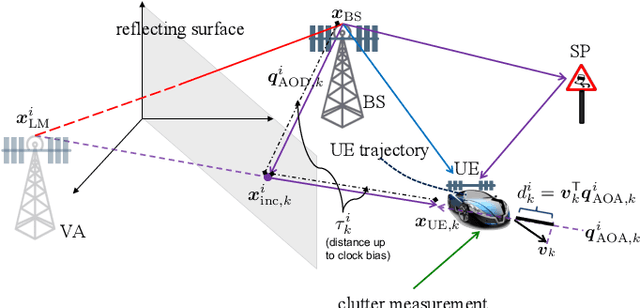
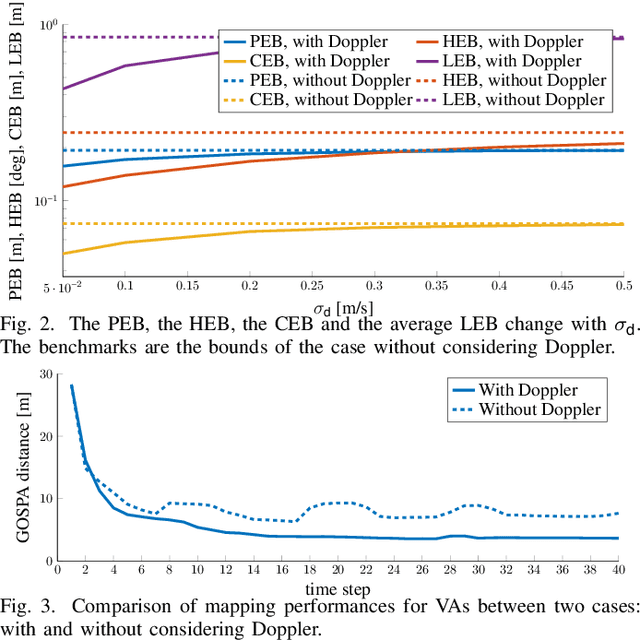
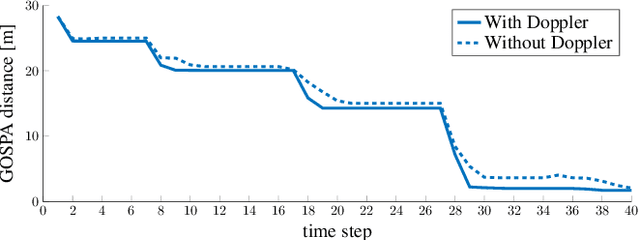
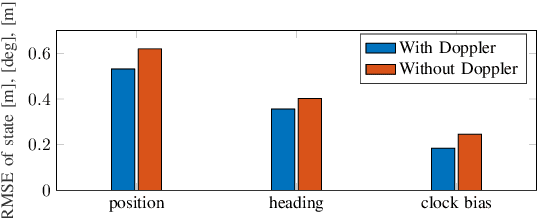
Abstract:Networks in 5G and beyond utilize millimeter wave (mmWave) radio signals, large bandwidths, and large antenna arrays, which bring opportunities in jointly localizing the user equipment and mapping the propagation environment, termed as simultaneous localization and mapping (SLAM). Existing approaches mainly rely on delays and angles, and ignore the Doppler, although it contains geometric information. In this paper, we study the benefits of exploiting Doppler in SLAM through deriving the posterior Cram\'er-Rao bounds (PCRBs) and formulating the extended Kalman-Poisson multi-Bernoulli sequential filtering solution with Doppler as one of the involved measurements. Both theoretical PCRB analysis and simulation results demonstrate the efficacy of utilizing Doppler.
A CNN Approach for 5G mmWave Positioning Using Beamformed CSI Measurements
Apr 30, 2022

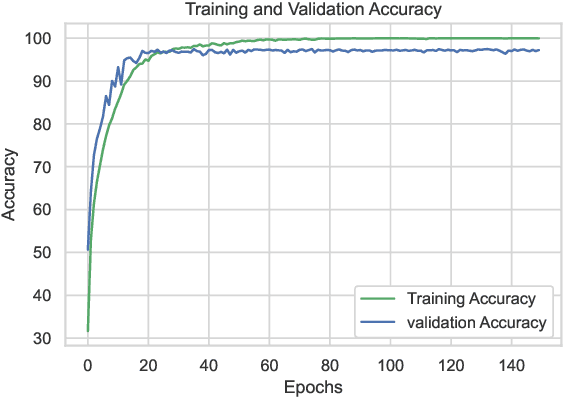
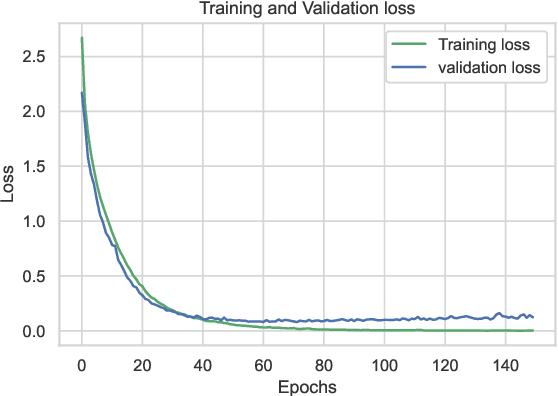
Abstract:The advent of Artificial Intelligence (AI) has impacted all aspects of human life. One of the concrete examples of AI impact is visible in radio positioning. In this article, for the first time we utilize the power of AI by training a Convolutional Neural Network (CNN) using 5G New Radio (NR) fingerprints consisting of beamformed Channel State Information (CSI). By observing CSI, it is possible to characterize the multipath channel between the transmitter and the receiver, and thus provide a good source of spatiotemporal data to find the position of a User Equipment (UE). We collect ray-tracing-based 5G NR CSI from an urban area. The CSI data of the signals from one Base Station (BS) is collected at the reference points with known positions to train a CNN. We evaluate our work by testing: a) the robustness of the trained network for estimating the positions for the new measurements on the same reference points and b) the accuracy of the CNN-based position estimation while the UE is on points other than the reference points. The results prove that our trained network for a specific urban environment can estimate the UE position with a minimum mean error of 0.98 m.
Iterated Posterior Linearization PMB Filter for 5G SLAM
Dec 05, 2021


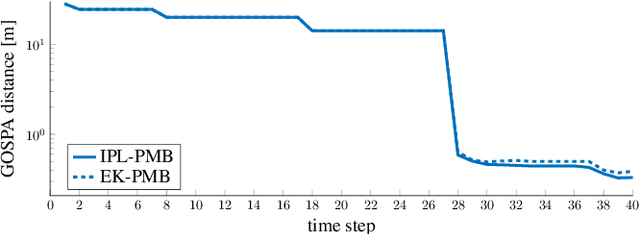
Abstract:5G millimeter wave (mmWave) signals have inherent geometric connections to the propagation channel and the propagation environment. Thus, they can be used to jointly localize the receiver and map the propagation environment, which is termed as simultaneous localization and mapping (SLAM). One of the most important tasks in the 5G SLAM is to deal with the nonlinearity of the measurement model. To solve this problem, existing 5G SLAM approaches rely on sigma-point or extended Kalman filters, linearizing the measurement function with respect to the prior probability density function (PDF). In this paper, we study the linearization of the measurement function with respect to the posterior PDF, and implement the iterated posterior linearization filter into the Poisson multi-Bernoulli SLAM filter. Simulation results demonstrate the accuracy and precision improvements of the resulting SLAM filter.
 Add to Chrome
Add to Chrome Add to Firefox
Add to Firefox Add to Edge
Add to Edge